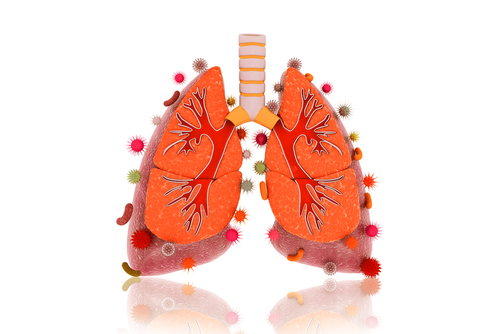People with bronchiectasis who acquire pneumonia in the community have fewer co-existing medical conditions and lower in-hospital mortality — but spend more time hospitalized and experience more Pseudomonas aeruginosa infections — than those without the irreversible inflammatory disease, a Spanish study showed.
Acquiring pneumonia while in the hospital led to fewer differences, although it also resulted in a greater frequency of P. aeruginosa infections compared with non-bronchiectasis patients.
Notably, P. aeruginosa an opportunistic bacteria found in the environment that takes advantage of an individual’s weakened immune system to create an infection.
The study, “Hospitalizations for Community-Acquired and Non-Ventilator-Associated Hospital-Acquired Pneumonia in Spain: Influence of the Presence of Bronchiectasis. A Retrospective Database Study,” was published in the Journal of Clinical Medicine.
Bronchiectasis patients are at a higher risk for respiratory infections such as pneumonia, in which the air sacs of the lungs fill with pus and other liquid. This disease can be acquired in multiple ways: in the community, and thus called community-acquired pneumonia (CAP); upon respiratory support with a ventilator, known as ventilator-associated pneumonia; and while in the hospital but not associated with ventilator use, when it is called non-ventilator hospital-acquired pneumonia (NV-HAP).
Scarce studies have examined the characteristics and numbers of CAP cases in people with bronchiectasis, and even fewer have investigated NV-HAP.
To fill this knowledge gap, researchers based at the Complutense University of Madrid, in Spain, launched an analysis of medical records in the Spanish National Health System. They compared the characteristics and in-hospital mortality rate of CAP and NV-HAP among patients with and without bronchiectasis during 2016 and 2017.
CAP was diagnosed in 10,230 people with bronchiectasis (3.97%) out of 257,455 total patients. People with bronchiectasis were significantly older than patients without this condition (mean age 75.5 vs. 68.6).
In turn, NV-HAP was identified in 354 individuals with bronchiectasis (2.07%) among 17,069 total patients. The mean age in this group also was higher (72.4) than in people with NV-HAP (65.8) but not bronchiectais.
Among the participants with CAP, those with bronchiectasis had significantly fewer co-existing medical conditions (comorbidities) than those without bronchietasis. Examples included heart attack, congestive heart failure, cerebrovascular disease, type 2 diabetes, cancer, and dementia.
In contrast, the prevalence of rheumatoid arthritis, mild liver disease, and peripheral vascular disease — a progressive circulation disorder — was significantly greater in people with bronchiectasis.
Within NV-HAP, people with bronchiectasis had higher prevalence of congestive heart failure, rheumatoid disease, and mild liver disease. However, these patients had a lower prevalence of cerebrovascular disease, and of hemiplegia or paraplegia — the loss of use of one or both legs.
The mean length of hospital stay was longer in CAP patients with bronchiectasis than those without (10.44 vs. 9.3 days). However, overall in-hospital mortality was significantly lower for CAP patients with bronchiectasis (7.89% vs. 11.81%). No differences in these two parameters were found within the NV-HAP group.
Both forms of pneumonia were more frequent among men than women, regardless of having bronchiectasis or not.
An analysis showed that the prevalence of all pneumonia pathogens (bacteria that cause disease) in CAP was significantly higher among bronchiectasis patients. The most frequently found microorganism was Streptococcus pneumoniae. Likewise, among patients with NV-VAP, the prevalence of P. aeruginosa was higher among individuals with bronchiectasis compared with those without the disease.
Then, the team found that older age was linked to higher in-hospital mortality in people with CAP. In contrast, older age correlated with lower mortality in people with NV-VAP.
Metastatic cancer, invasive mechanical ventilation, and dialysis while in the hospital increased the risk of death in patients with CAP and NV-HAP.
People with CAP showed an increased risk of death if they had congestive heart failure, dementia, cancer, and moderate or severe liver disease. Lower mortality was found in patients with S. pneumoniae and Haemophilus influenzae infections.
Finally, the scientists found that people diagnosed with bronchiectasis and CAP were less likely to die during hospitalization than those without bronchiectasis.
“Patients with CAP and BQ [bronchiectasis] have less comorbidity, lower IHM [in-hospital mortality] and a longer mean length of stay than non-BQ patients,” the researchers wrote. “However, they had a higher number of isolated microorganisms, including Pseudomonas aeruginosa.”
“More studies with more accurate methodological approaches will be necessary before we can confirm our findings and further characterize this subgroup of patients,” they concluded.

